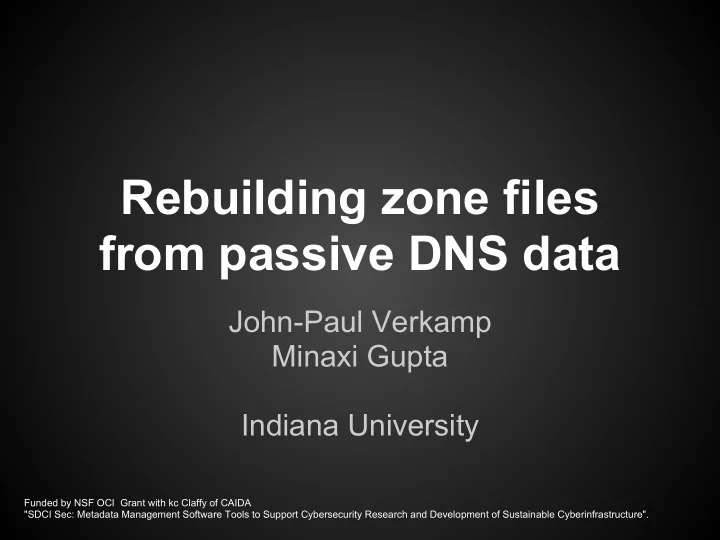

Rebuilding zone files from passive DNS data John-Paul Verkamp Minaxi Gupta Indiana University Funded by NSF OCI Grant with kc Claffy of CAIDA "SDCI Sec: Metadata Management Software Tools to Support Cybersecurity Research and Development of Sustainable Cyberinfrastructure".
Motivation ● Zone files for the largest gTLDs, especially . com are (non-commercially) available ● Zone files for most ccTLDs aren't often available ● Passive DNS data exists, we can use it to rebuild zone files for any TLD
Data Sources ● DNSParse ● ISC/SIE
Data Sources - DNSParse ● Per day: ○ ~ 100 MB of data ○ ~ 4M DNS records
Data Sources - ISC/SIE Unpacked and Further de-duplication deduplicated DNS Removal of generically Raw passive DNS named records and payloads high volume wildcards ● Per hour: ○ ~ 1 GB of data ○ ~ 23 million entries
Algorithm Reconstruct zone files Parse records Local verification Merge timestamps Apply smoothing
Algorithm - Parse Records ● DNSParse ○ Gzipped comma separated values ○ Contains: query, answer, rrtype, ttl, firstseen, lastseen, sensorID ● ISC/SIE ○ Binary format: libnmsg ○ Contains: section, qname, qtype, qclass, rrname, rrtype, rrclass, rrttl, rdata ● We want: ○ rrtype, query, response, first, last, ttl
Algorithm - Merge Timestamps ● Timestamps are stored as a binary tree with each leaf being a pair / time range ● Each new record has the time it was first seen, last seen, and a time to live ○ add (first, last + ttl) to the tree ● Merge overlapping records to save memory and insertion time, rebalance on update
Algorithm - Smoothing ● After each collection of records (hourly), timestamps are smoothed ● Assumption is that domains that have been long lived but have short lapses before returning to the previous value remained active ● Short lived domains and those that disappear for long periods of time are not smoothed ● Parameters for "short lived" and "long periods of time" are still being tweaked
Algorithm - Local Verification ● After local data has been added ● Attempted on domains that have been inactive for a long enough period of time ● If local verification matches the original record, the timestamps will be smoothed ● If it doesn't return or no longer exists, no further local verification will take place
Algorithm - Reconstruction ● Zone files can be reconstructed for any zone file for any day ● Scan for that day's time stamp for valid domains
Results - DNSParse ● Using 9 months of DNSParse data: ○ 6% of .com, 5% of .net ○ data is too sparse to accurately smooth, resulting in slowing growth ○ many ccTLDs are nearly empty
Results - Growth of ● Older results after 5 months: (number of unique domains in zone file)
Results - ISC/SIE ● Using 1 month of ISC/SIE data: ○ 52% of .com, 43% of .net ○ smoothing is accurate enough that the data is still growing, albeit slower ○ at current growth, estimates are ~70% of .com ○ even the smaller ccTLDs have tens of thousands of domains, still some variability within
Questions?
Recommend
More recommend